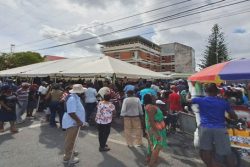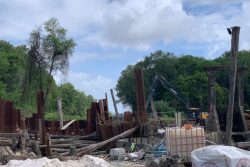A Guyanese woman late last year was given a reprieve in her bid to gain refugee status in Canada by a judge who set aside the initial denial of her request by the Immigration and Refugee Board after she alleged that she was escaping an abusive husband in Guyana.
“This court’s judgment is that the application for judicial review is allowed, the decision of the board is set aside and the matter is referred to a different panel of the board for redetermination,” Judge John A O’Keefe said in his ruling late last December.
In its ruling, the immigration board had determined that the woman was not a conventional refugee within the meaning of section 96 of the Refugee Act nor a person in need of protection as defined in subsection 97(1) of the Act.
Giving a background to the case Justice O’Keefe said the woman, whose name was withheld, was born in Guyana in 1958 and married her husband in 1980. While the marriage went well initially and the couple had two children, the man subsequently joined a criminal gang and began drinking. He later became very violent and started abusing the woman and using weapons and many times he abused her in front of the children who after they became adults left the woman alone with her alcoholic abuser.
“The applicant repeatedly reported the abuse to the Guyanese police, but they only warned the husband and refused to get involved in domestic matters. The abuse continued, including strangling and death threats. Her husband was kicked out of the gang and this led to more drinking and bitterness,” the judge said in the ruling.
She later filed for divorce but the man further threatened her and kept a loaded gun in the house and she went into hiding before being granted a visitor’s visa to attend her niece’s wedding in 2007. Five years later she claimed protection stating that she feared her ex-husband would kill her if she returned to Guyana.
However, in February of last year the refugee board denied her request stating that Guyana was presumed capable of protecting its citizens. In considering the country conditions documents, the board found that they were mixed and inconclusive, since some of the text indicated Guyana’s domestic violence protection mechanisms were inadequate, while other parts indicated reasonably functional protection was available for women fearing domestic violence. It excerpted the full text of a 2008 response to an information request on domestic violence in Guyana as well as the relevant portion of the 2008 United States Department of State Human Rights Report. It also noted that the state had made efforts to protect the woman on five occasions, although they were inadequate. It further noted that the woman had not made any effort to seek protection in the past several years and that local police failures in themselves did not amount to a general lack of state protection.
However, the woman sought a review of the decision, pointing out that the documentary evidence indicates there is a well-founded fear of persecution given the backdrop of country conditions in Guyana. She argued that she was not given police protection and that the board overlooked evidence showing the lack of police protection. She stated that any evidence that indicates it is safe for a woman to be in Guyana when a gang member has threatened to kill her is due to media bias and that it was unfair for the board to focus on documents showing Guyana is safe as opposed to her documents
In his decision, the judge pointed out that it was of little comfort to a person fearing persecution that a state has made an effort to provide protection if that effort has little effect. He said for that reason, the board is tasked with evaluating the empirical reality of the adequacy of state protection.
He noted that the board repeatedly described Guyana’s conditions documents as “mixed” in its conclusions on state protection, since “some of the text in the most recent documents indicates that Guyana’s domestic violence state protection mechanisms are inadequate” but “other text in the same recent documents tells a different story and indicates Guyana has reasonably functional state protection mechanisms.”
He said he believes the board’s error in stating the proper legal test for state protection is also reflected in its finding that the evidence is “mixed”. That is, the country conditions evidence is really a mix of (1) clear statements that state protection is inadequate and (2) descriptions of various efforts made by the Guyanese state.
He said one document states that domestic violence in Guyana is widespread; at least one out of every three women in Guyana has reportedly been a victim of domestic violence; and some victims are still unaware of their rights and may be too afraid to file a report; when victims do file a complaint, police sometimes offer little support.
On the other hand it was stated that there are NGOs providing services to victims of domestic violence; there is legislation prohibiting domestic violence; the police receive training on protecting victims; and the government launched a national policy on domestic violence.
“When state protection analysis is properly applied, it is clear that the ‘serious efforts’ listed above are not proper evidence of the adequacy of state protection,” the judge however said.
He pointed out that a law on the books or a training session for police may not lead to the outcome of adequate protection.
According to the judge, it is not the court’s role to reweigh evidence and his comments should not be taken as speaking to the weight of any particular piece of evidence. Rather, the issue is that the board misunderstood the proper test for state protection and its evidentiary findings were sufficiently tainted by that misunderstanding that it could not disentangle them.
“In my view, on the facts of this case, the applicant has rebutted the presumption of state protection,” he ruled.





